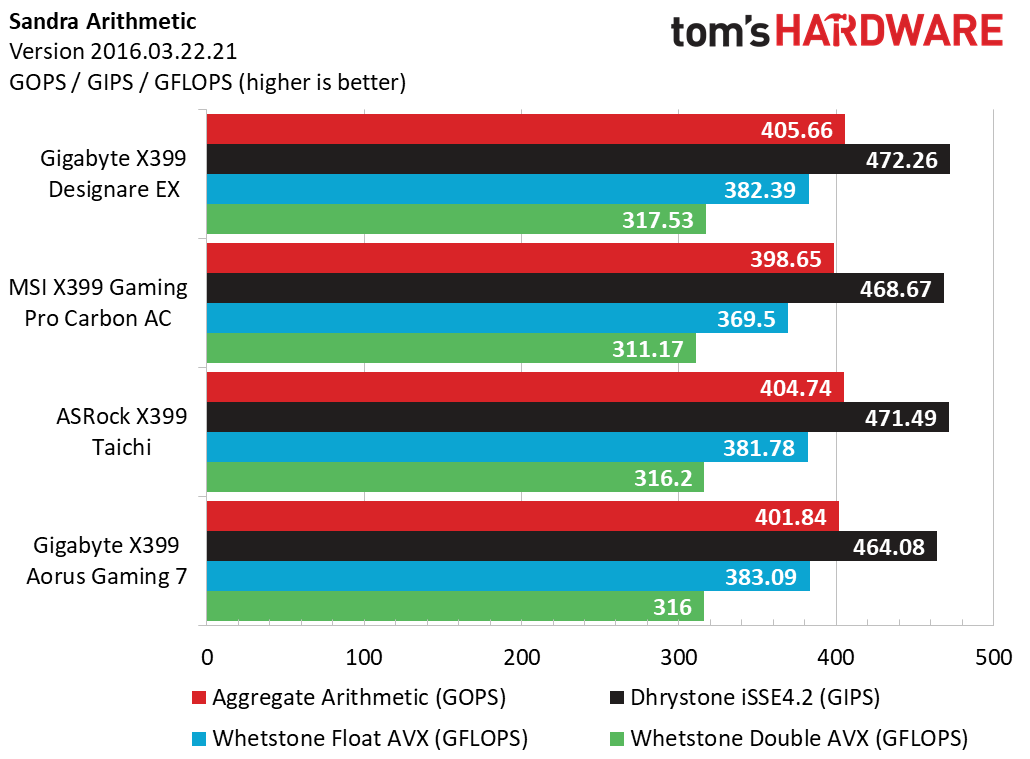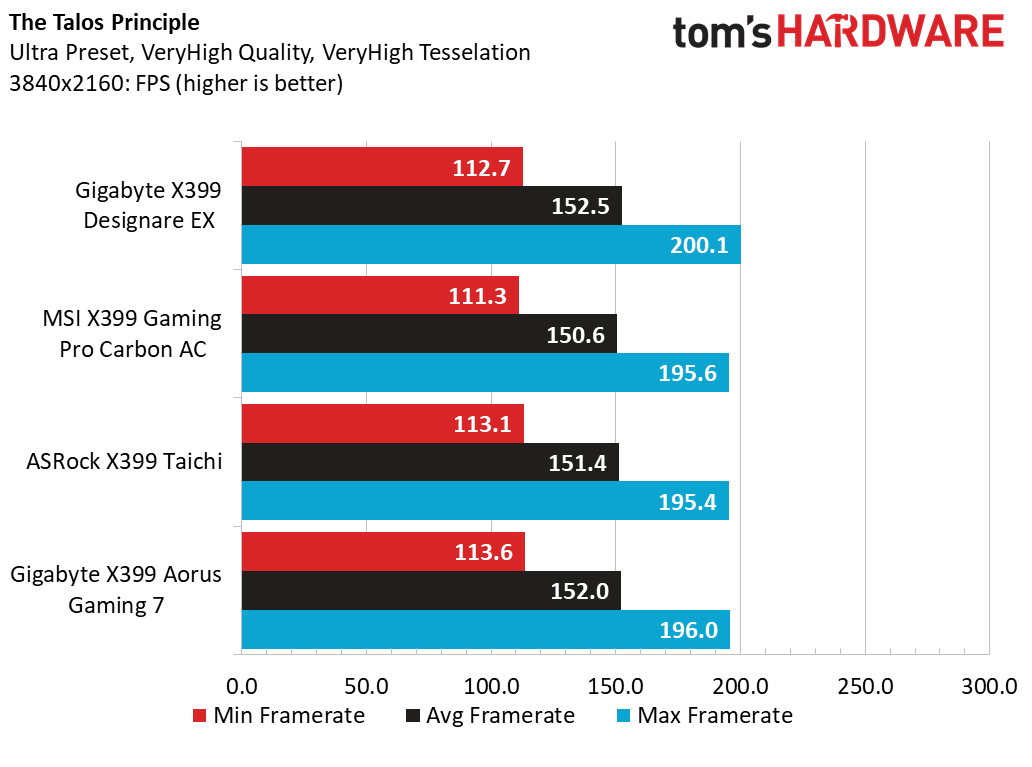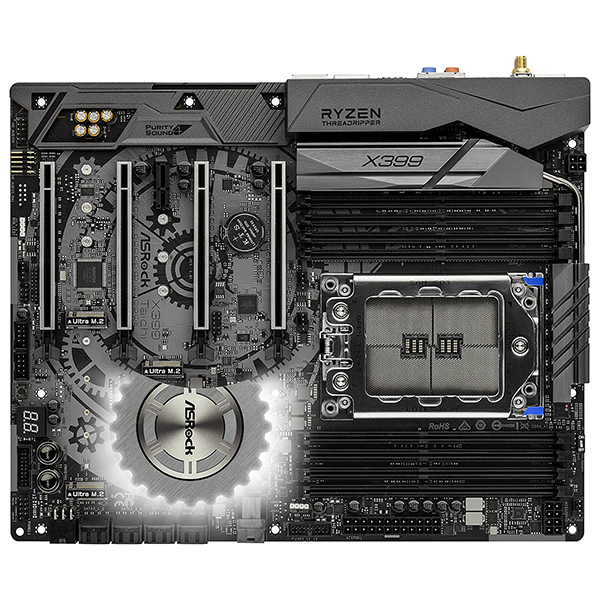Gigabyte X399 Designare EX Motherboard Review
Why you can trust Tom's Hardware
Synthetics & Gaming Benchmarks
Comparison Products
Synthetics & Applications




Having a full set of Creative Mode data now makes it fairly straightforward to identify any basic trends in our hardware setup, so we will spend a little more time with the synthetics today than usual. Our sixteen core 1950X loves Sandra’s benchmarks, with each of the motherboards showing consistent results across the Arithmetic, Multimedia, Cryptography, and Memory Bandwidth. Having said that, we do observe a few intricacies with the data. In the Multimedia workload, the Integer and floating point AVX results seem to round to the nearest 0.0010 GPix/s as we break the 1GPix barrier, which skews the data a bit. Also, in the Cryptography and memory workloads, we see deltas of up to 2 GB/s. That's hardly noticeable, but it does impact our overall performance results.


PCMark08 decides to take Sandra’s consistency and throw it out the window. Though we do our best to keep chipset, GPU, and operating system conditions similar between reviews, we still can’t rule out that some environmental variable is impacting our results in a measurable manner. The Home, Work, Creative, and Office workloads clearly favor the Designare’s environment, with upwards of 11 percentage points separating the next contender. Oddly, Adobe decides to rain on the Designare’s parade and places that board in last place. Nevertheless, Storage is our only reliable workload showing less than 0.11 percent separating all the samples.
Speaking of storage, our IOmeter workload is now a standard sight in our synthetics segment, and each motherboard sample reviewed wins at least one of the individual metrics today. With performance deltas of between and 10.5 percentage points, the Gigabyte X399 Gaming Pro Carbon AC’s squeaks ahead overall with disk performance.


Cinebench R15 still produces consistent results when comparing single and multi threaded scores. With a 3 point win on single-thread and a 14 point lead on the ASRock Taichi, the Gigabyte X399 Aorus Gaming 7 wins this round. Compubench results show the Designare performing well in three of the four graphed workloads, but this board in fact wins in the majority of this more graphics-intensive suite.



As we shift over to the 3DMark workloads, we start to see each of these boards starting to take wins for various metrics, which is a good thing. For Skydiver, the Designare configuration is completely overkill at 720p and rakes in healthy wins for everything but the Physics tests. We still can’t explain the Taichi’s gruesome defeat here, but it does come back with Firestrike and wins all the categories. As for the Designare, a second-place finish with Firestrike continues to slip as its Physics score pulls it to third place in Firestrike Extreme.
Game Benchmarks & Overall Performance


Gaming is not particularly Threadripper's ideal use case, but with the right components it can be a powerhouse of frames, effects, and butter-smooth gameplay. As we’ve experienced with prior reviews, F1 2015 continues struggle with the high core counts of the 1950X, and appears to bind up once we enable more than 24 cores. After tweaking our automation XMLs, the Designare still lags behind by up to 11 frames per second at 1080p and Ultra High detail settings, which translates to nearly a five-percentage-point gap between it and the Aorus Gaming 7. At 4k, the MSI Carbon Pro Gaming AC takes the lead, but the variance between the test samples is hardly noticeable while playing the game.




The Talos Principle shows some interesting trends. At 1080p and High details, the Designare lags by 12 percentage points compared to the MSI, and at Ultra settings the leads tighten and the Aorus Gaming 7 Takes the lead with a virtual tie for second between the Taichi and the Designare. At UHD, the spreads continue to tighten at high detail when compared to 1080p, and our worst-case Talos run gives the Designare the edge for average and max framerates.
Get Tom's Hardware's best news and in-depth reviews, straight to your inbox.




With Metro Exodus on track for a PC release (pardon the pun), we can’t help but get excited every time we watch our bundled benchmark of Metro Last Light Redux run across our test display. Since we only factor in average framerates to our performance calculations, the Designare laags behind by roughly two frames at 1080p at both detail settings. At 4k, each of the tested motherboards shows practically identical results for all metrics, with slight variances observed in maximum frame rates.




Lastly, Ashes of the Singularity: Escalation continues to thrash the core counts of our 1950X, and shows a 2.9 percentage point loss at 1080p High and a 3.8 percentage loss for the Designare on the Crazy setting. As we observe in other games, increasing the resolution on this platform shows a tightening of the deltas across samples. But 4k High settings defeat the Designare here. On the bright side, the Designare nearly squeaks a 1 percentage point win against the Taichi at Crazy. But overall, each of these boards is more than adequate for gaming.
We have seen some close performance results in our previous AMD motherboard coverage, but this bunch of boards shows each board excelling in a few different areas. The Designare has a large lead compared to the competition in the synthetic realm, but lags in games which place it at the #2 spot in terms of overall combined performance. Interestingly enough, the Aorus Gaming 7 scored well with gaming and applications. The Taichi and Gaming Pro Carbon follow close behind, favoring gaming and applications respectively.
MORE: Best Motherboards
MORE: How To Choose A Motherboard
MORE: All Motherboard Content
Current page: Synthetics & Gaming Benchmarks
Prev Page UEFI & Test Configuration Next Page Overclocking, Power, Thermal Benchmarks & Conclusion-
GeoffCoope It has no 10GBase-T port? so not really a board that could be used in a workstation with 4 x GPU's.Reply -
Flying-Q ReplyReally. It has ps2 ports. WHO STILL USES PS2
I have an old and very robust mechanical keyboard which I would not trade for any of your modern rubbish. It was built when PS/2 was still new and will outlive (and has already outlived) many so-called 'rugged' keyboards that my work has.



